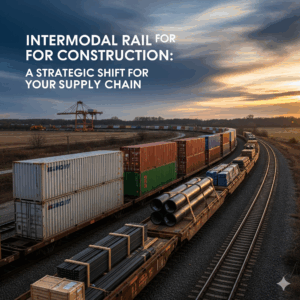In 2025, rail shipping in Canada is more than a logistics option – it’s a smart, strategic decision that can save your business time, money, and operational headaches. With the rising costs of fuel, labour shortages in the trucking industry, and increasing environmental concerns, rail shipping has become a key player in the Canadian freight economy. Businesses of all sizes are turning to intermodal rail shipping to improve long-haul efficiency, reduce greenhouse gas emissions, and ensure goods arrive safely and on schedule.
Rail shipping involves transporting freight over the Canadian National (CN) and Canadian Pacific Kansas City (CPKC) rail networks, often combined with truck transportation in an intermodal setup. This blend of rail and road creates a seamless, secure, and scalable logistics solution. Whether you’re shipping raw materials from Alberta to Ontario or finished goods from Vancouver to Montreal, rail shipping offers a dependable and eco-friendly way to move cargo across Canada’s expansive geography.
One of the greatest advantages of rail shipping is its cost-effectiveness. Trains can move large volumes of goods over long distances at a lower cost per unit than trucks. For industries that ship bulk materials, such as manufacturing, agriculture, and retail, the savings are significant. Additionally, Canadian rail lines are well-integrated with ports, terminals, and transloading facilities, making it easy to connect domestic freight to global markets.
Security and reliability are also top benefits of rail shipping in Canada. Unlike trucking, railcars are less susceptible to road hazards, traffic delays, or weather disruptions. With modern tracking technologies and dedicated rail lanes, shippers can monitor freight in real time and ensure it arrives safely. In an era where supply chain delays can cost businesses millions, rail shipping provides the predictability and transparency today’s operations demand.
To succeed with rail shipping in Canada, businesses need to understand how to properly prepare shipments, select the right containers, coordinate intermodal transitions, and maintain compliance with carrier policies. The upcoming 7-step guide will show how to plan effectively, avoid damage or claim disputes, and maximize the full potential of rail shipping.
By embracing these strategies, your company can streamline operations, reduce carbon output, and build a more resilient supply chain. Whether you’re new to rail shipping or looking to refine your current strategy, this guide will give you the tools and insights needed to ship smarter in 2025.

A Glimpse into Canadian Intermodal Railway Shipping
Canada’s economy relies heavily on the smooth and cost-effective movement of goods – both imports and exports – to keep supply chains running and businesses thriving. At the heart of this system lies intermodal rail shipping, a critical mode of freight transportation that links the country’s vast geography through an integrated network of railways, ports, and terminals. In 2022 alone, Canadian railways transported over 330 million tons of goods, enabling the distribution and sale of nearly $200 billion worth of Canadian products across North America and beyond.
From bulk commodities like grain, coal, and lumber to containerized consumer goods and manufacturing inputs, intermodal rail is the workhorse behind much of Canada’s domestic and international trade. It enables shippers to take advantage of economies of scale while maintaining delivery timelines, all while reducing greenhouse gas emissions compared to over-the-road trucking.
One of the strongest selling points of intermodal rail shipping in Canada is its affordability. With some of the lowest freight rates in the developed world, Canadian railways offer businesses a competitive edge, especially when shipping large volumes or long-haul loads. This lower cost-per-ton-mile helps manufacturers, agricultural exporters, and logistics providers remain lean and efficient – something that’s more important than ever in today’s inflationary environment.
But the value doesn’t end with price. Canada’s two Class I railroads, CN and CPKC, are continuously investing in infrastructure, technology, and network expansion to improve intermodal connectivity. Their strategic partnerships with ports on the Atlantic and Pacific coasts provide seamless transloading options for international shipments, making Canada a gateway for global trade.
Ultimately, Canadian intermodal rail isn’t just a mode of transport – it’s a strategic advantage. It strengthens economic resilience, supports sustainable logistics, and helps Canadian businesses reach markets faster, cheaper, and with less risk.
7 Steps for Shifting to Intermodal Rail Shipping in Canada
Rail shipping offers a reliable and efficient means of transporting goods across the nation. Its popularity among businesses is increasingly growing. And for that If you are thinking about switching to rail shipping for your transportation needs, there are seven essential steps to follow. Such as –
- Understanding Intermodal Rail Shipping:
Intermodal Rail shipping is different from other modes of transportation, such as trucking or air freight. It involves loading goods onto railcars and transporting them across the country via a network of railway tracks. Understanding the basics of rail shipping will help you make informed decisions about its suitability for your business.
- Securing Your Cargo:
Before you can begin shipping your goods by rail, you’ll need to secure them properly. This involves packaging them in a manner that ensures their safe transportation and protects them from potential damage during transit. Additionally, you may need to obtain specific documentation or permits depending on the nature of your cargo.
- Types of Cargo:
Railways offer a variety of services to accommodate different types of cargo. Common rail shipping options include:
- Flatcars: Used for transporting oversized or heavy equipment.
- Intermodal containers: Standardized containers that can be easily transferred between different modes of transportation, such as rail and truck.
- Bulk materials: Suitable for transporting large quantities of commodities like grains, coal, and minerals.
- Project cargo: Specialized shipments that require specialized handling and equipment.
- Rail Routes and Regulations:
Railways operate on a network of tracks that connect various regions across Canada. Understanding the available routes will help you determine the most efficient path for your shipment. Additionally, it’s important to be aware of the regulations governing intermodal rail transportation, as compliance with these rules is essential for ensuring a smooth shipping process.
- Choosing the Right Rail Shipping Company:
Not all rail shipping companies offer the same services or rates. It’s crucial to research different providers and compare their offerings to find the best fit for your business. Consider factors such as their reputation, experience, service offerings, and pricing.
- Obtaining a Freight Quote:
Once you’ve identified your cargo type and chosen an intermodal rail shipping company, it’s time to obtain a freight quote. This will provide you with an estimate of the shipping costs involved, allowing you to make informed decisions about your transportation options.
- Negotiation:
Rail shipping companies are often open to negotiation, especially for large or regular shipments. Don’t hesitate to discuss your specific needs and explore potential discounts or special offers.
To select the most suitable rail shipping option, it’s essential to assess your specific needs. Consider factors such as the destination of your shipment, the required delivery time, and the weight and dimensions of your goods. This information will help you determine the appropriate type of railcar and the most efficient route for your shipment.
By following these steps and carefully considering your options, you can effectively utilize rail shipping to transport your goods efficiently and cost-effectively.

Reason why you should Shift to Rail transportation
Intermodal Rail transportation not only offers a highly efficient model for businesses to move materials globally. It has other benefits too, such as –
Cost Savings
Intermodal Rail transportation often proves more cost-effective than trucking, especially for large volumes of merchandise. By shipping higher quantities at once, companies can benefit from lower operating costs per mile.
Environmental Sustainability
Intermodal Rail freight is a more environmentally friendly alternative to trucking. It contributes to reduced highway congestion and offers better fuel efficiency than trailers, resulting in lower greenhouse gas emissions. This makes rail an attractive option for businesses seeking to minimize their environmental impact.
Enhanced Security
Intermodal Rail shipments generally enjoy a higher level of security compared to other forms of transportation. The dedicated rail network is continuously monitored by rail authorities, ensuring a safer environment for your goods.
Faster Shipping
Intermodal Rail transportation is becoming increasingly efficient, making it an excellent choice for businesses that require timely deliveries. By avoiding the congestion and delays often associated with road transportation, rail can help you meet your “just-in-time” delivery schedules.
Convenient Door-to-Door Service
Even if your facilities lack direct rail access, many rail shipping companies offer door-to-door service. This provides flexibility and convenience for businesses that require pickup or delivery options beyond loading docks.
Main Things To Keep In Mind For Intermodal Railway Transportation
When preparing for rail freight, businesses should be aware of several key factors. Rail transportation operates differently from trucking or other familiar modes of transport in North America. As trains follow specific rules and regulations regarding the weight, size, and type of materials they can carry.
It’s important to note that rail transportation does not accept certain hazardous materials, such as radioactive, corrosive, or flammable substances. If you need to ship these items, you’ll need to explore alternative transportation methods or ensure they are properly labeled and packaged for safe rail transport.
Understanding these differences will help businesses prepare their shipments effectively and avoid potential delays or issues.
Conclusion
As Canada continues to modernize its freight infrastructure and invest in greener transportation initiatives, rail shipping is cementing its place as a preferred logistics solution. From the Prairies to the Atlantic, more businesses are choosing rail over road to overcome shipping bottlenecks, meet customer expectations, and improve profit margins. If you’ve been on the fence about rail shipping, now is the time to invest in a strategy that pays long-term dividends.
The environmental benefits of rail shipping are especially compelling. Trains can move one ton of freight more than 400 kilometers on a single litre of fuel, reducing emissions and helping businesses meet sustainability goals. Government incentives and corporate pressure to lower carbon footprints make rail an attractive choice for socially responsible organizations.
Moreover, rail shipping boosts operational efficiency. It reduces the need for large trucking fleets, minimizes driver-related delays, and lowers maintenance costs. As labour shortages and road congestion continue to challenge supply chains, rail offers a scalable, consistent solution for moving freight across Canada with less risk and fewer disruptions.
Another key factor in rail shipping success is strategic planning. This includes building strong partnerships with 3PL providers, understanding container compatibility, mastering documentation requirements, and leveraging digital tools like GPS and shipment tracking. With the right systems in place, businesses can monitor cargo in real time and resolve issues before they escalate.
Education and training are also critical. Your logistics team must stay up to date with the latest rail carrier policies, terminal access requirements, and freight classifications. Continuous learning ensures your operations remain compliant, cost-efficient, and ready for growth. As rail networks expand and new intermodal hubs emerge, being an early adopter of smart rail shipping practices puts your business ahead of the curve.
In conclusion, rail shipping in Canada isn’t just about moving goods – it’s about transforming how your business approaches logistics. From cost savings and sustainability to improved reliability and reduced risk, the advantages are too compelling to ignore. By following the seven steps laid out in this guide and continually investing in process improvements, your organization can unlock the full potential of rail shipping in 2025 and beyond.
Make rail shipping a cornerstone of your logistics strategy this year. With proper planning, reliable partnerships, and a commitment to best practices, you’ll enjoy faster delivery times, fewer claims, and a stronger competitive position in your market.

FAQ
- What is rail shipping?
Rail shipping is the transportation of goods using trains, often as part of a broader supply chain strategy. It’s a key mode within intermodal logistics, where freight is moved efficiently over long distances by rail. Rail shipping is ideal for transporting heavy loads, bulk commodities, and containerized freight across Canada and North America. - How does intermodal rail shipping work?
Intermodal rail shipping combines the efficiency of trains with the flexibility of trucks to move freight in sealed containers. Goods are loaded once and transported across multiple modes—usually truck to rail and back to truck – without being unpacked. This reduces handling, lowers the risk of damage, and streamlines logistics across long distances. - Why is rail shipping more cost-effective than road?
Rail shipping offers lower costs per unit for large volumes of freight, especially on long-haul routes. Trains are more fuel-efficient than trucks and can carry more goods per trip, leading to better economies of scale. This makes rail shipping particularly cost-effective for heavy, dense, or bulk freight. - Is rail shipping more sustainable?
Yes, rail shipping is considered one of the most environmentally friendly freight transport options. Trains emit significantly fewer greenhouse gases per ton-mile than trucks and use less fuel. For companies with ESG goals, rail shipping can be a smart move toward greener logistics. - Can small businesses benefit from rail shipping?
Absolutely – rail shipping isn’t just for large enterprises. Small businesses can tap into intermodal rail networks by working with freight forwarders or third-party logistics providers (3PLs). These partners help bundle shipments, arrange documentation, and secure cost-effective space without requiring full container loads. - What types of goods are suitable for rail shipping?
Rail shipping is ideal for dry goods, bulk commodities, packaged products, electronics, and some non-perishable food items. Its stability and scalability make it suitable for many types of freight that don’t require rapid delivery or extreme temperature control. Containers offer excellent protection during long-distance rail transit. - Are rail shipments trackable?
Yes, modern rail shipping offers strong visibility through GPS and real-time tracking tools. Most rail carriers in Canada provide shipment updates, location scans, and estimated arrival times. This allows businesses to monitor freight throughout its journey and manage logistics proactively. - What documents are required for rail shipping in Canada?
Key documents include a bill of lading, cargo manifest, and proper shipping labels. If the rail shipping route involves cross-border transit, customs declarations and import/export paperwork are also needed. A 3PL or customs broker can help ensure compliance and avoid delays. - How do I prevent damage during rail shipping?
To prevent damage in rail shipping, use high-quality packaging, bracing, and load-securing materials inside the container. Railcars experience vibration and shifting during transit, so stabilizing cargo is critical. Partnering with experienced rail carriers also reduces risk by ensuring proper handling throughout the journey. - Is rail shipping faster than trucking?
In some cases, yes—especially for long-distance or cross-country routes. Rail shipping can bypass road congestion and weather-related traffic delays common to highway transport. While trucks offer more flexibility at the local level, rail often provides faster transit between major hubs. - What is the role of a 3PL in rail shipping?
A third-party logistics provider (3PL) coordinates all aspects of the rail shipping process. This includes booking containers, scheduling carrier pickups, managing documentation, and tracking freight. 3PLs also negotiate better rates and offer tailored solutions for intermodal shipping in Canada. - Do rail carriers in Canada offer reefer containers?
Yes, major Canadian rail carriers like CN and CPKC offer temperature-controlled reefer containers. These containers maintain consistent temperatures during transit, making them ideal for perishable or temperature-sensitive goods. Rail shipping with reefer containers is a reliable solution for pharmaceuticals, food, and specialty products. - How do I get started with rail shipping in Canada?
To get started with rail shipping, begin by evaluating your freight volume and transit needs. Consult a 3PL or freight broker to explore available routes, container options, and carrier rates. They’ll help you prepare shipments according to intermodal standards and ensure a smooth onboarding process.
Additional Resources
- Transport Canada – Rail Transportation
https://tc.canada.ca/en/rail-transportation
Overview of regulations, safety, and programs related to Canada’s rail shipping industry. - Association of American Railroads (AAR) – Freight Rail & Intermodal
https://www.aar.org/freight-rail/intermodal/
Data and insights into the intermodal sector, including rail freight trends across North America. - Canadian National Railway (CN) – Intermodal Shipping
https://www.cn.ca/en/our-services/intermodal/
Information on CN’s intermodal services, container options, schedules, and advantages. - Canadian Pacific Kansas City (CPKC) – Rail Intermodal Services
https://www.cpkcr.com/en/our-business/intermodal
Details about CP’s intermodal shipping capabilities, routes, and customer support tools. - Railway Association of Canada (RAC)
https://www.railcan.ca/
Policy, advocacy, and news from Canada’s primary rail industry association. - Statistics Canada – Rail Transportation Data
https://www150.statcan.gc.ca/n1/en/subjects/transportation/rail_transportation
Comprehensive rail freight volume, distance, and commodity data across provinces. - Port of Vancouver – Rail Connections and Intermodal Terminals
https://www.portvancouver.com/about-us/project-overview/intermodal/
An overview of Canada’s largest port and its integration with national rail shipping networks. - Government of Canada – Trade and Transportation Corridors Initiative
https://www.infrastructure.gc.ca/ttc-itt/index-eng.html
Federal initiative investing in better infrastructure to support faster and safer rail shipping. - North American Transportation Statistics – Rail Freight Activity
https://nats.sct.gob.mx/
Cross-border data on intermodal and rail shipping between Canada, the U.S., and Mexico. - Journal of Commerce (JOC) – Rail & Intermodal News
https://www.joc.com/rail-intermodal
Current news, policy updates, and trend analysis related to rail shipping and logistics.
How We Can Help
For businesses looking to optimize their freight shipping with reliable, efficient, and cost-effective solutions, RailGateway.ca is your trusted partner in intermodal logistics. Whether you’re new to freight trains or want to enhance your existing supply chain, our team of intermodal experts is ready to guide you every step of the way.
Contact RailGateway.ca today for a free quote or to speak directly with one of our experienced intermodal specialists. Let us help you unlock smarter, smoother shipping solutions tailored to your unique needs.
Visit RailGateway.ca or call us to get started on transforming your freight shipping strategy in 2025 and beyond.





